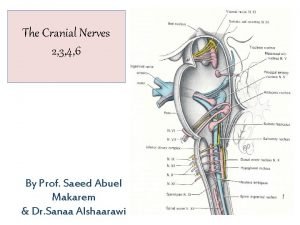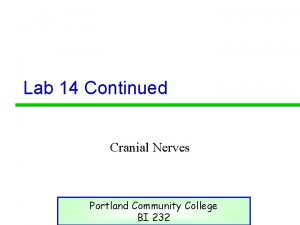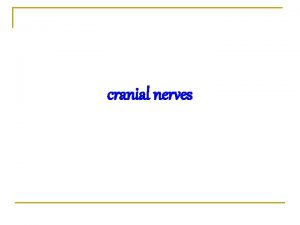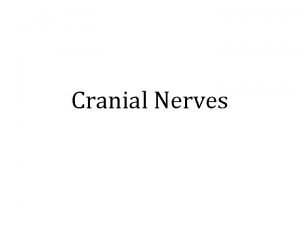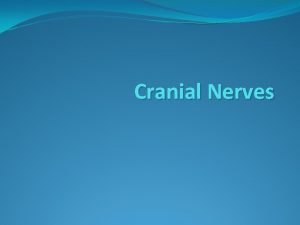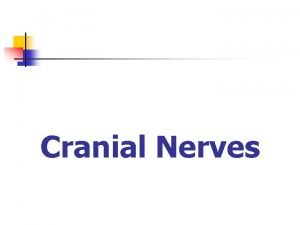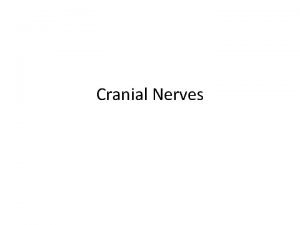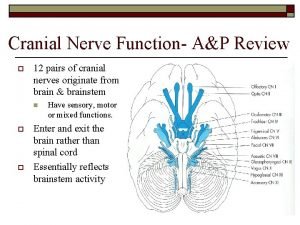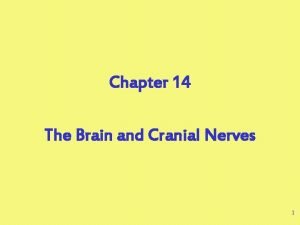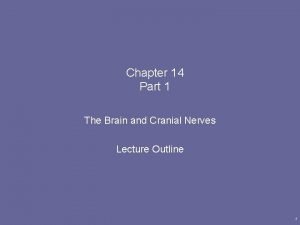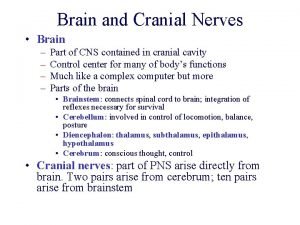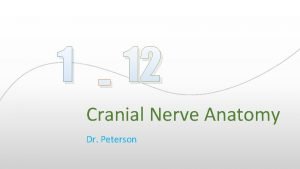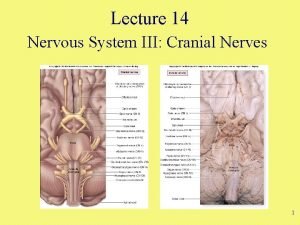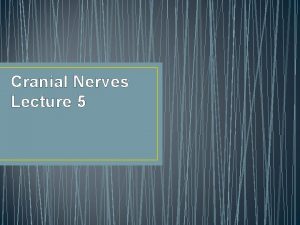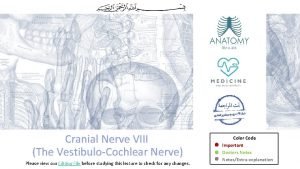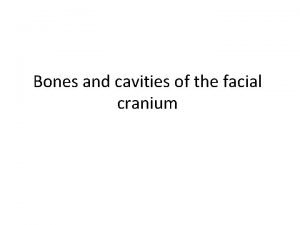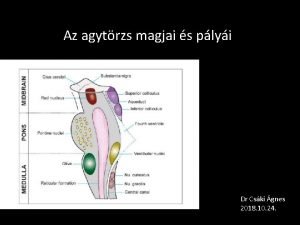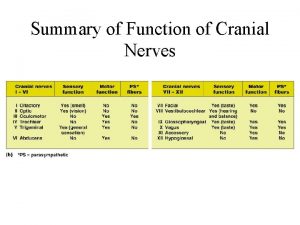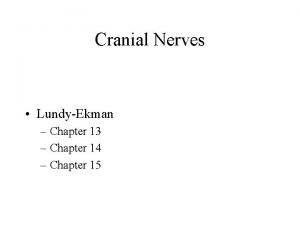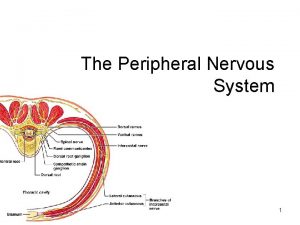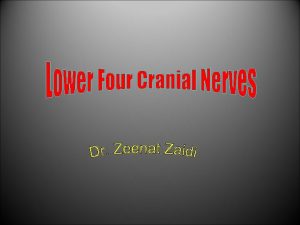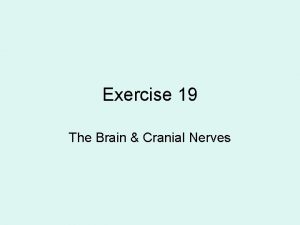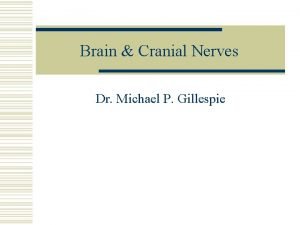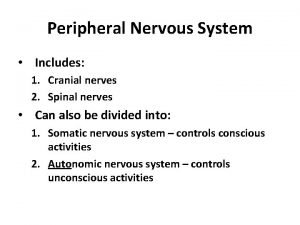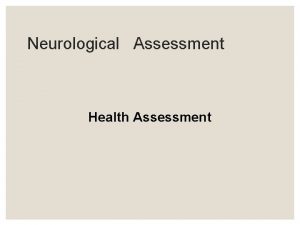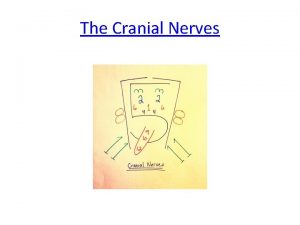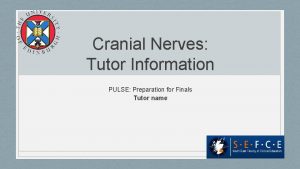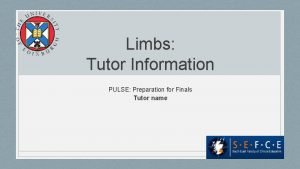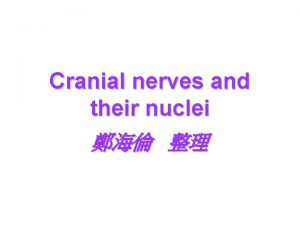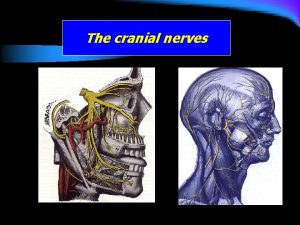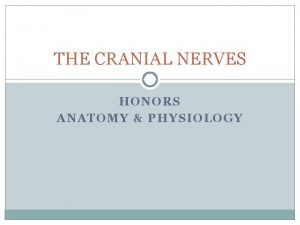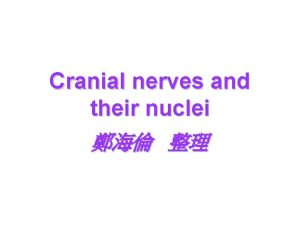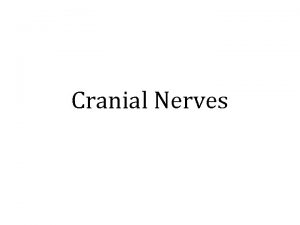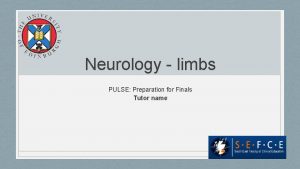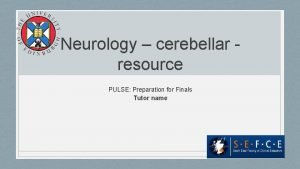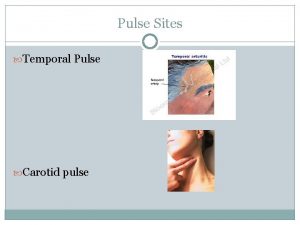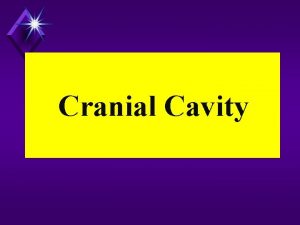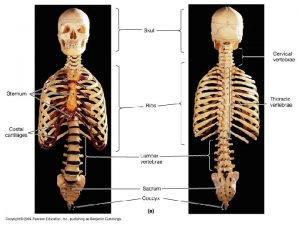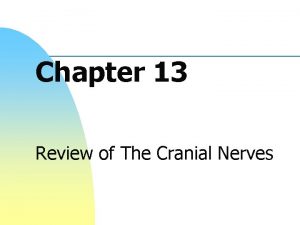Cranial Nerves PULSE Preparation for Finals Tutor name






























- Slides: 30

Cranial Nerves PULSE: Preparation for Finals Tutor name

Tu. BS attendance • https: //tutorialbooking. com/

Session overview • Common cranial nerve conditions for the OSCE • How to present your findings • Summary of clinical signs • Case presentations and viva questions

What is the purpose of an OSCE? “This station tests a student’s ability to perform an appropriate focussed physical examination, demonstrating consideration for the patient, and to report back succinctly describing the relevant findings. It also tests a student’s clinical judgement i. e. the ability to decide the differential diagnosis, choose investigations and formulate a management plan. ”

Common cranial nerve conditions in the OSCE • It is highly unlikely you will be asked to examine ALL cranial nerves • Ophthalmoplegia • Field defects • Facial nerve palsy

Presenting your findings • What were you asked to do? • What were your key positive findings? • What were the important negative findings? • What does this mean? • How would you complete your examination, and what investigations would you do?

Example case presentation • I was asked to examine the cranial nerves of this elderly gentleman • On examination I found that he had a failure of lateral gaze in the left eye • All other eye movements were intact, visual acuity was normal, and there were no visual field defects • No abnormalities in the other cranial nerves were detected • This would be consistent with a diagnosis of a 6 th nerve palsy • To complete my examination I would like to perform fundoscopy and do a full neurological examination of the limbs – FURTHER TESTS

Completing your examination • Complete cranial nerves examination • Formal tests • • • 1: scents 2: Snellen and Ischiara charts 3, 4, 6: fundoscopy, corneal reflex 7: jaw jerk 9: gag reflex • Perform fundoscopy • Full neurological examination of the limbs

Investigations • Bloods; FBC, U&E, LFTs, glucose, B 12/folate • Imaging; CXR (paraneoplastic/ Horners), CT, MRI (posterior lesions, cord) • LP; cells, oligoclonal bands, xanthochromia • Other; nerve conduction studies

Clinical signs

Oculomotor nerve palsy CN III - Down and out - Ptosis - Fixed dilated pupil - Causes - vasculitic (DM, HTN) - aneurysm (PCAA) - Medical vs surgical - Medical: DM: pupil sparing - Surgical: fixed, dilated pupil - Parasympathetic fibres run along the periphery and are the first to be affected by compression

Why is the pupil spared in diabetic palsies?

Trochlear Cranial Nerve Palsy CN IV - Superior oblique - Head tilt - Vertical diplopia - Causes - vasculopathic - tumour - congenital - trauma

Abducens Palsy: CN VI - Unopposed action of medial rectus - Causes - Vasculopathic (DM, HTN) - Tumour - Intracranial pressure: false localising sign

Cranial Nerve Cases

Case 1

Examination of CN I-III • WINDEC • STAND BACK: observe +closely at eyes • CN III

Case 1 – CN I - III • Normal smell • Normal fields • Also impaired looking to far left – left eye essentially fixed, bulging from socket • Pupils non reactive to light

Case 1 – CN V onwards • Sensation – decreased in upper and mid face, normal in beard region • Facial movements otherwise normal • Tongue movements normal and symmetrical • Hearing intact. Renne +ve; Weber NAD • Normal cough and speech • No neck wasting or weakness Please present your findings.

Case 2

Case 2 - eyes • PERLA • Eye movements normal (? small amount of nystagmus) • Normal visual fields • Sensation reduced on right throughout

Case 2 – CN V onwards • Reduced facial movements on right, including right forehead • Partially deaf on right side – Rinne’s – air louder, Weber’s – left louder • Normal cough and voice • Tongue movements normal • No neck muscle wasting, no weakness • Bonus points – on walking, he falls to the right • Bonus bonus – past pointing Please present your findings.

Case 3

Case 3 Please present your findings.

What is Horner’s syndrome? • Horner’s Syndrome • = collection of signs: • unilateral pupillary constriction (miosis), • ptosis and • anhydrosis (i. e. loss of sympathetic pathway on that side).

What are the causes of Horner’s syndrome? • Hemisphere and brainstem • Massive cerebral infarction • Pontine glioma • Vascular disease (esp. lateral medullary syndrome – infarction of lateral medulla, due to occlusion of vertebral artery, posterior inferior cerebellar artery, superior, middle or inferior medullary arteries) • ‘Coning’ of the temporal lobe • T 1 root • Apical bronchial neoplasm (usually SCC) • Apical TB Cervical rib • Brachial plexus trauma or tumour Sympathetic chain in neck • Post thyroid/laryngeal surgery • Malignancy, e. g. thyroid; neoplastic infiltration • Cervical sympathectomy • Carotid artery • Occlusion/dissection • Pericarotid tumours (Raeder’s syndrome) • Cluster headache Cervical cord • Syringomyelia • Cord tumours • • • Miscellaneous • Congenital • Migrainous neuralgia (usually transient) • Isolated and unknown cause

Cranial nerve summary

Groups of nerve palsies • III and IV – midbrain nuclei • V, VII, VIII – pons nuclei • IX, X, XII – medulla nuclei • Unilateral III, IV, VI, Va – cavernous sinus lesion; superior orbital fissure lesion (Tolosa-Hunt syndrome) • Unilateral V, (VI), VIII, (IX) – cerebellopontine angle lesion (usually tumour) • Unilateral IX, X, XI – jugular foramen lesion • Eye and facial muscles, worse on exertion – myasthenia gravis • UMN IX, X, XII – pseudobulbar palsy • LMN IX, X, XII – bulbar palsy

Summary • Common cranial nerve conditions for the OSCE • How to present your findings • Summary of clinical signs • Case presentations and viva questions

Please complete Tu. BS feedback • Tutor details • For more information on Examining for Finals sessions: • examiningforfinals@gmail. com • www. sefce. net/pulse • Resource Updated 2017: Dr A Swan • With thanks to previous contributors: • Dr Emma Claire Phillips (FY 2) • Dr Kristina Lee (FY 2)
 Edinger westphal nucleus
Edinger westphal nucleus Exercise 15 spinal cord and spinal nerves
Exercise 15 spinal cord and spinal nerves Cranial nerve 7 origin
Cranial nerve 7 origin Afferent cranial nerves
Afferent cranial nerves Label cranial nerves
Label cranial nerves Cranial nerves
Cranial nerves Cranial nerve acronym
Cranial nerve acronym Olfactory nerve
Olfactory nerve Cranial nerves classification
Cranial nerves classification Testing vestibulocochlear nerve
Testing vestibulocochlear nerve Cranial nerves labeled with roman numerals
Cranial nerves labeled with roman numerals Figure 14-2 cranial nerves labeled
Figure 14-2 cranial nerves labeled Crossed extensor reflex
Crossed extensor reflex Accessory nerve (xi)
Accessory nerve (xi) First and second cranial nerves
First and second cranial nerves Folyos
Folyos Oh oh oh to touch and feel
Oh oh oh to touch and feel On olympus towering tops
On olympus towering tops First and second cranial nerves
First and second cranial nerves Perpendicular plate of palatine bone
Perpendicular plate of palatine bone Tractus occipito temporo pontinus
Tractus occipito temporo pontinus Cranial nerves mnemonic
Cranial nerves mnemonic Ipsilateral cranial nerves
Ipsilateral cranial nerves Proprioception cranial nerves
Proprioception cranial nerves Saphenous nerve plexus
Saphenous nerve plexus Pharyngeal plexus
Pharyngeal plexus Meninges
Meninges Cranial nerve 4 function
Cranial nerve 4 function Bridging veins
Bridging veins Mnemonic for cranial nerves
Mnemonic for cranial nerves Brachioradialis reflex
Brachioradialis reflex
